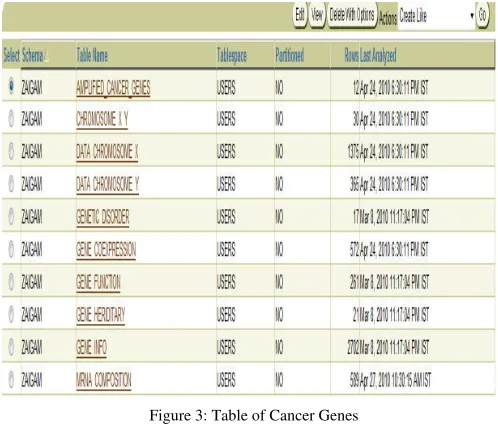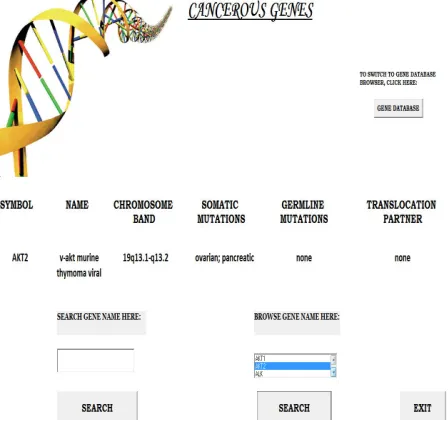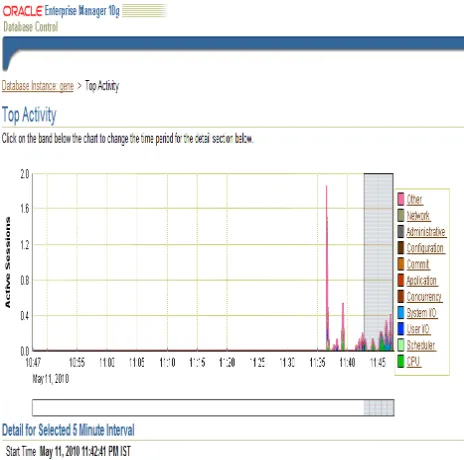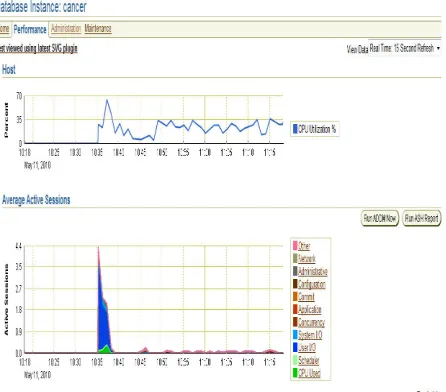!
"
# #
"$ % %#
&
''' (
ISSN No. 0976-5697
Creation of Gene Database and Implementation of Transaction Processing
Muhammad Rukunuddin* Ghalib and Kauser Ahmed P School of Computing Sciences and Engineering, VIT
University Vellore, India
ruk.ghalib@vit.ac.in, kauserahmed@vit.ac.in
Jaigam Dilshad
School of Biosciences and Technology, VIT University Vellore, India
dilshad.sbst@gmail.com
Abstract: A rich set of concepts and techniques has been used in the context of gene database creation and transaction processing along with performance and tuning for the efficient and robust execution of queries. So far, this work has mostly focused on issues related to data-retrieval queries. However, update operations can also exhibit a number of query processing issues, depending on the complexity of the operations and the volume of data to process. Such issues include lookup and matching of values, navigational vs. set-oriented algorithms and trade-offs between plans that do serial or random I/Os .In this paper we present an overview of the basic techniques used to support SQL DML (Data Manipulation Language) in ORACLE database 10g. Our focus is on the collection of gene information and implementation of some concepts of transaction operations and performance and tuning operation into the gene database and cancer database. Although atomicity is a well studied topic in transaction processing and business workflows, such an important capability needs to be revisited in a scientific workflow environment. Atomicity needs to be defined in dataflow-oriented scientific workflow model. The basic principles of all transaction-processing systems are the same. However, the terminology may vary from one transaction-processing system to another.
Keywords: GeneBank, SQL DML, DB Transaction Management, Tuning.
I. INTRODUCTION
During the past decade, the massive growth in genetic and protein databases has created a pressing need for tools to manage, retrieve and analyze the information contained in these libraries. Traditional tools to organize, classify and extract information have often proved inadequate when confronted with the overwhelming size and density of information which includes not only sequence and structural data, but also text that describes the data origin, location, species, tissue sample, journal articles, and so forth. As of this writing, the NCBI (National Center for Biotechnology Information, part of the National Institutes of Health) GenBank library alone consists of nearly 84 billion bytes of data and it is only one of several data banks storing similar information. The scope and size of these databases continues to rapidly grow and will continue to do so for many years to come as will the demand for access.
Currently, retrieval of genomic data is mainly based on well-established programs such as FASTA and BLAST that match candidate nucleotide sequences against massive libraries of sequence acquisitions. There have been few efforts to provide access to genomic data keyed to the extensive text annotations commonly found in these data sets. Among the few systems that deal with keyword based searching are the proprietary SRS system and protein information resource (PIR). These are limited, controlled vocabulary systems whose keys are from manually prepared annotations. To date, there have been no systems reported to directly generate indices from the genomic data sets themselves. The reasons for this are several: the very large size of the underlying data sets, the
size of intermediate indexing files, the complexity of the data, and the time required to perform the indexing.
Database consists of an organized collection of data for
one or more multiple uses. One way of
classifying databases involves the type of content, for example: bibliographic, full-text, numeric, and image. Other classification methods start from examining database architectures [1],[4],[7]. A number of database architectures exist. Many databases use a combination of strategies.
Databases consist of software-based "containers" that are structured to collect and store information so users can retrieve, add, update or remove such information in an automatic fashion. Database programs are designed for users so that they can add or delete any information needed. The structure of a database is tabular, consisting of rows and columns of information.
A database management system (DBMS) consists of software that organizes the storage of data. A DBMS controls the creation, maintenance, and use of the database storage structures of social organizations and of their users. It allows organizations to place control of organization wide database development in the hands of Database Administrators (DBAs) and other specialists. In large systems, a DBMS allows users and other software to store and retrieve data in a structured way.
vendors of object databases implement this, majority of them do implement this method. A great deal of the internal engineering of a DBMS is independent of the data model, and is concerned with managing factors such as performance, concurrency, integrity, and recovery from hardware failures. In these areas there are large differences between the products. A relational database management system (RDBMS) implements features of the relational model. In this context, Date's "Information Principle" states: "the entire information content of the database is represented in one and only one way, namely as explicit values in column positions (attributes) and rows in relations (tuples). Therefore, there are no explicit pointers between related tables." This contrasts with the object database management system (ODBMS), which does store explicit pointers between related types.
A gene is a unit of heredity in a living organism. It is normally a stretch of DNA that codes for a type of protein or for an RNA chain that has a function in the organism [2]. All proteins and functional RNA chains are specified by genes. All living things depend on genes. Genes hold the information to build and maintain an organism's cells and pass genetic traits to offspring. A modern working definition of a
gene is "a locatable region of genomic sequence,
corresponding to a unit of inheritance, which is associated with regulatory regions, transcribed regions, and or other functional sequence regions "[3]. Colloquial usage of the term gene (e.g. "good genes, "hair color gene") may actually refer to an allele: a gene is the basic instruction, a sequence of nucleic acid (DNA or, in the case of certain viruses RNA), while an allele is one variant of that instruction.
The human genome is the genome of Homo sapiens,
which is stored on 23 chromosome pairs. Twenty-two of these are autosomal chromosome pairs, while the remaining pair is sex-determining. The haploid human genome occupies a total of just over 3 billion DNA base pairs. The Human Genome Project (HGP) produced a reference sequence of the euchromatic human genome, which is used worldwide in biomedical sciences.
The haploid human genome contains ca. 23,000 protein-coding genes, far fewer than had been expected before its sequencing. In fact, only about 1.5% of the genome codes
for proteins, while the rest consists of non-coding
RNA genes, regulatory sequences, introns, and
(controversially named) "junk" DNA[3],[4].
The Cancer Gene Census is an ongoing effort to
catalogue those genes for which mutations have been causally implicated in cancer. The original census and analysis was published in Nature Reviews Cancer and supplemental analysis information related to the paper is also available [2].
II. RELATED WORK
A. Indexing genomic sequence libraries
Most genomic databases include, in addition to nucleotide and protein sequences, a wealth of information in the form of descriptions, keywords, annotations, hyper-links to text articles journals and so forth. In many cases, the text attachments to the data are greater in size than the actual sequence data. Identifying the important keyword terms from
this data and assigning an elative weight to these terms is one of the problems addressed in this system. Indexing helps to improve query processing and performance that helps to speed up retrieval of values [1], [3], and [8].
B. Constraint acquisition for Entity-Relationship models Integrity constraints are conditions that capture the semantics of the application domain under consideration. They restrict the databases to those that are considered meaningful to the application at hand. In practice, the decision of specifying a constraint is very important and extremely challenging.
C. Atomicity and provenance support for pipelined scientific workflows
Atomicity is an important transactional property, which requires that a transaction either runs to completion or has no partial effect (all-or-nothing). In scientific workflows, some tasks might fail during execution due to either the failure of the task itself or inappropriate input to a task. A domain scientist might require the execution of a sub-workflow to be atomic in the sense that either the execution of all the tasks of the sub-workflow runs to completion or none of them has any effect at all[1],[6].
D. Efficiently supporting secure and reliable collaboration in scientific workflows
The transactional support is widely used to address the reliability of systems [6], [7]. In traditional database systems and work- flows, the consistency of sharing data and administration among components can be achieved through implementing strict transaction semantics in terms of atomicity, consistency, isolation and durability (ACID). Although extremely reliable, traditional ACID transactions are not suitable for loosely coupled environments such as Web service-based business transactions. This is because fine-grained lock controls and full trustworthiness are not generally applicable in Web services-based transactions.
III METHODOLOGY
• Collection of human gene related information from various
database.
• Classifying the collected information into different criteria. • Create different tables to add this information.
• Implement the concept of performance and tuning and
transaction processing.
A. Steps involved in creating database
• Installing the Oracle 10g database software is a separate process from that of creating a database
• GENE Databases can be created using the Database
Configuration Assistant (DBCA tool) or manually using the CREATE DATABASE command
• When creating a GENE Database manually it is best to
generate scripts using DBCA first, and then to edit them
• The DBA authentication method determines how Oracle
10g validates users logging on with SYSDBA or SYSOPER
• OS authentication relies on the OS’s security to validate the
user/password, and authorization group.
• The REMOTE_LOGIN_PASSWORDFILE parameter is set
to NONE for OS authentication.
• Password file authentication stores user names and
passwords and group membership in an encrypted file in the OS
• Set REMOTE_LOGIN_PASSWORDFILE to EXCLUSIVE
for password file authentication.
• The ORAPWD utility generates the password file for
SYSDBA and SYSOPER and then the database maintains it with changes to passwords.
• Control files can be multiplexed (each subsequent control
file is an exact copy of the first control file).
• Multiplexed copies of control files should be located on
different physical devices to guard against damage.
• Prevent bottlenecks in data access by placing data on several
physical devices (spreads the demand).
• User-managed file management offers more detailed
control over datafiles than Oracle Managed Files, but requires more manual maintenance tasks.
• DBCA provides an opportunity to customize memory size
and initialization parameters.
• Adjusting of tablespace/datafile sizes and locations
depends on the DB type selected using DBCA.
• After creating GENE database, use Net Manager to set up
a Net Service name for the database.
• Collection of various information regarding GENE from
various sources.
• Adding these information into users schema
• Implement queries to extract information from GENE
DATABASE.
• Implementation of transaction processing concepts.
• Implementation of database performance and tuning
concept.
B. Creating a Database Using DBCA
DBCA enables us to create a database from predefined templates provided by Oracle or from templates that we or others have created. A template is a description of a database.
C. Selecting the Template
DBCA displays the templates that are available, which includes templates that Oracle ships with the DBCA product. If we or others have created templates, those will be displayed also. We select the appropriate template for the database that we want to create. Clicking the "Show Details..." button displays specific information about the database defined by a template.
IV. IMPLEMENTATION
A. Considerations before Creating a GENE Database
Database creation prepares several operating system files to work together as an Oracle database. We need only create a database once, regardless of how many datafiles it has
or how many instances access it. Creating a database can also erase information in an existing database and create a new database with the same name and physical structure.The following topics can help prepare us for database creation.
• Planning for database creation
• Meeting creation prerequisite
• Deciding how to create GENE database
B. Meeting Creation Prerequisites
To create a new database, the following prerequisites must be met:
• The desired Oracle software is installed. This includes
setting up various environment variables unique to our operating system and establishing the directory structure for software and database files.
•
• We have the operating system privileges associated with a
fully operational database administrator. We must be specially authenticated by our operating system or through a password file, allowing we to start up and shut down an instance before the database is created or opened.
• There is sufficient memory available to start the Oracle
instance.
• There is sufficient disk storage space for the planned
database on the computer that executes Oracle.
C. Specifying Mode, Initialization Parameters, and Datafiles The next pages enable us to further define our database. We specify mode (dedicated server of shared server), set initialization parameters, and specify datafile locations. Oracle can determine specific values for we based upon our description of the database we are trying to create. For example, Oracle can choose appropriate settings for SGA memory sizing parameters depending upon whether we select a typical or custom database.
D. Completing Database Creation
After we have completed the specification of the parameters that define our database we can:
• Create the database now
• Save the description as a database template
• Generate database creation scripts
Figure 1: Parameterized locations for datafills
E. Implementing Transactions and Performance Tuning Concepts
A transaction is a logical unit of work that contains one or more SQL statements. A transaction is an atomic unit. The effects of all the SQL statements in a transaction can be either all committed (applied to the database) or all rolled back (undone from the database).A transaction begins with the first executable SQL statement. A transaction ends when it is committed or rolled back, either explicitly with a COMMIT or ROLLBACK statement or implicitly when a DDL statement is issued [5],[6],[7],[8]. Tuning graphs are shown in figures 8, 9, 10, 11.
F. Rollback of Transactions
Rolling back means undoing any changes to data that have been performed by SQL statements within an uncommitted transaction. Oracle uses undo tablespaces (or rollback segments) to store old values. The redo log contains a record of changes.
Oracle lets us roll back an entire uncommitted transaction. Alternatively, we can roll back the trailing portion of an uncommitted transaction to a marker called a savepoint. All types of rollbacks use the same procedures:
• Statement-level rollback (due to statement or
deadlock execution error)
• Rollback to a savepoint
• Rollback of a transaction due to user request
• Rollback of a transaction due to abnormal process
termination
• Rollback of all outstanding transactions when an
instance terminates abnormally
• Rollback of incomplete transactions during recovery
V. RESULTS AND DISCUSSIONS
Organizing collected information in different table to create GENE and Cancerous gene database After collecting all the information related to genes and cancerous gene my target is to arrange all these collected information into ORACLE DATABASE to create two separate database . GENE database listed all the information about genes,
CANCEROUS gene database list only the gene those are responsible for cancer. In order to create gene database in a much organized way we create several tables using SQL in ORACLE DATABASE 10g as given in figure 2.
[image:4.612.320.552.109.315.2]Figure 2:creating gene tables using oracle databse 10G
Figure 3: Table of Cancer Genes
A. Query of the gene and cancer database to retrieve the values
In order to retrieve the values from these databases (figure 3) we have to perform query which list the set of information related to these databases. Cancer Database instance is shown in figure 12.
Query 1
[image:4.612.323.572.349.561.2]"TRANSLOCATION_PARTNER" FROM "AMAN"."CANCEROUS_GENES"
Figure 4: Output of Query I
Query 2
SELECT "GENE_SYMBOL", "GENE_NAME", "DESCRIPTION", "GENBANK#", "UNIGENE#" FROM "AMAN"."GENE_INFO"
Figure 5: Output of Query II
Query 3
[image:5.612.34.279.85.295.2]SELECT "SYMBOL", "NAME", "ENTREZ_GENEID", "CHR", "CHR_BAND", "MUTATION_TYPE" FROM "AMAN"."CANCEROUS_GENE_CHROMOSOME"
Figure 6: Output of Query III
To access the information from database in user-friendly way we create an application using visual basic. This application run in graphical user mode (figure 7) and accepts the search term from user to print the output.
Figure 7: Application in graphical user mode
B. Savepoints in Transactions
We can declare intermediate markers called savepoints within the context of a transaction. Savepoints divide a long transaction into smaller parts.
[image:5.612.35.280.378.551.2] [image:5.612.324.548.400.614.2]transaction. For example, we can use savepoints throughout a long complex series of updates, so if we make an error, we do not need to resubmit every statement.
Savepoints are similarly useful in application programs. If a procedure contains several functions, then we can create a savepoint before each function begins. Then, if a function fails, it is easy to return the data to its state before the function began and re-run the function with revised parameters or perform a recovery action.
After a rollback to a savepoint, Oracle releases the data locks obtained by rolled back statements. Other transactions that were waiting for the previously locked resources can proceed. Other transactions that want to update previously locked rows can do so.
When a transaction is rolled back to a savepoint, the following occurs:
1. Oracle rolls back only the statements run after the savepoint.
2. Oracle preserves the specified savepoint, but all savepoints that were established after the specified one are lost.
3. Oracle releases all table and row locks acquired since that savepoint but retains all data locks acquired previous to the savepoint.
[image:6.612.336.562.61.190.2]4. Record the transaction in the transaction journal Oracle must allow for two situations. If all three SQL statements can be performed to maintain the accounts in proper balance, the effects of the transaction can be applied to the database. However, if a problem such as insufficient funds, invalid account number, or a hardware failure prevents one or two of the statements in the transaction from completing, the entire transaction must be rolled back so that the balance of all accounts is correct.
Figure 8: Performance tuning graph of the transaction processes
[image:6.612.321.555.61.709.2]Figure 9: Instance Disk I/O and Instance throughput
Figure 10: Sessions Tuning Activity
[image:6.612.328.551.226.412.2] [image:6.612.45.277.460.690.2]Figure 12: Database instance for Cancer Genes
VI. CONCLUSION AND FUTURE ASPECTS
Our database consists of an organized collection of data for one or more multiple uses. One way of classifying databases involves the type of content, for example: bibliographic, full-text, numeric, and image. Other classification methods start from examining database architectures. A number of database architectures exist. Many databases use a combination of strategies. Until our database is perfectly tuned it is not efficient.
Oracle includes numerous data structures to improve the speed of Oracle SQL queries. Taking advantage of the low cost of disk storage, Oracle includes many new indexing algorithms that dramatically increase the speed with which Oracle queries are serviced. Voluminous amount of information collected from different databases are stored in Gene Database and Cancer Database in an organized manner. Implementation of concept of performance and tuning helps to smooth database performance. Indexing the table provides a best solution to minimize the query execution plan.
In traditional database systems and work-flows, the
consistency of sharing data and administration among components can be achieved through implementing strict transaction semantics in terms of atomicity, consistency, isolation and durability (ACID). Although extremely reliable, traditional ACID transactions are not suitable for loosely coupled environments such as Web service-based business transactions. This is because fine-grained lock controls and full trustworthiness are not generally applicable in Web services-based transactions. Although a number of proposals are presented to address this issue, currently, the existing Web service frameworks still lack effective models and approaches for the reliable (fault-tolerant, transactional) execution of a group of Web services is our future focus.
This project comprises of voluminous information about Human Gene and Human Cancerous gene which will greatly help researcher to retrieve all the information regarding their research without browsing so many database.
Accessing these information in graphical modes from any platform (Linux, windows, solaris) through the browser convenient to researcher.
VII. REFERENCES
[1] Melanie R. Nelson, Stephanie J. Reisinger, Stephen G. Henry, “Designing databases to store biological information”, Biosilico, 2003, Volume 1, Issue 4 Pages 134-142
[2] Patricia G Baker, Andy Brass, “Recent developments in biological sequence databases”, Current Opinion in Biotechnology, 1998, Volume 9, Issue 1, Pages 54-58 [3] Edmond J. Breen, Keith L. Williams, “Hash function
performance on different biological databases”,
Computational Methods Programs, Biomed, 1989, Volume 28, Issue 2, Pages 87-91.
[4] Graham Chen, “Distributed transaction processing
standards and their applications”, Computer Standards &
Interfaces archive, 1995,
Volume 17, Issue 4, Pages: 363 - 373
[5] Ranjit Bose, Stephen D. Burd,”Control and coordination of heterogeneous transaction processing systems”, Information and Software Technology, 1997, Volume 39, Issue 3, Pages 171-184.
[6] Özgür Ulusoy, “Transaction processing in distributed active real-time database systems”, Journal of Systems and Software, 1998, Volume 42, Issue 3, Pages 247-262
[7] Philip A. Bernstein, Eric Newcomer, “Transaction
Processing Application Architecture”, Principles of Transaction Processing (Second Edition), ISBN: 978-1-55860-623-4.



